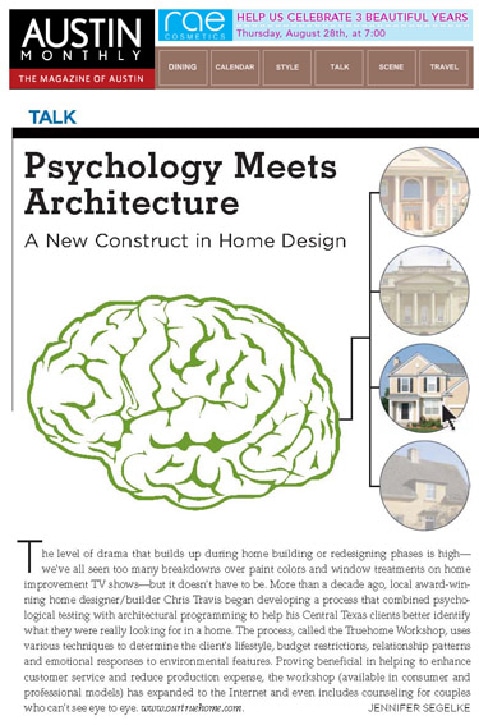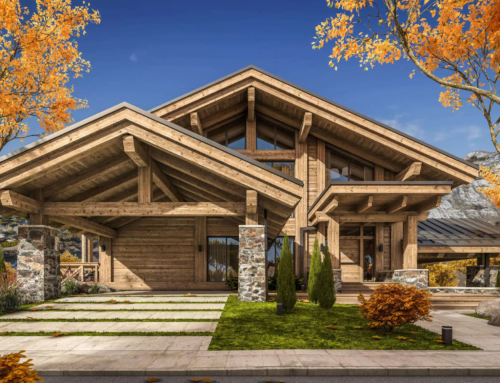Continued from Emotional Architecture – One
By Christopher K. Travis

Home on the Brain
Modern Neuropsychology suggests that less than five per cent of human actions are determined by planned, conscious thought. The remaining 95% of human behavior is strongly impacted by emotion, feeling (sensory and somatic), and other unconscious influences.
Decisions about homes are particularly vulnerable to these types of “irrational” decisions as homes serve an ancient and instinctive role in human life, one that has substantial unconscious cultural and instinctive underpinnings.
In real practice, though consumers give lip service to rationality when changing their living space, their decisions are often highly influenced by factors that are beyond their conscious awareness. They are motivated by developmental or instinctive environmental cues in memory associated with past experiences. Those memories and instincts elicit neurotransmitter and/or hormone stimulated emotional response.
In other words, they make most of their decisions based largely on how they feel, while being reasonably certain they are making thoughtful, rational, conscious choices.
The Impact
Evidence of this fact is that the home improvement industry in the U. S. is perennially the largest source of consumer complaints by industry sector.
Real estate agents – despite their central role in the largest sector of the U. S. economy outside of government – are consistently rated amongst the “least trusted” professionals in the nation.

The custom home building and home improvement sectors are enormously fragmented and inefficient given the vast scope of their activities. Building a single home typically involves as many a twenty or more distinct installation and service businesses – all with separate management, employees, policies and procedures – involved directly in the manufacture on a single small building. Hundreds and even thousands of products are involved, most with an enormous overlap in their functions.
No other industry of that stature has escaped what is typically an inevitable centralization of providers in the marketplace, despite the obvious economic advantages involved. Most consumers now assume there is no holistic way to approach altering their living space and for the most part, they are right.
On the home front, interpersonal issues between co-habitants during the planning and construction of home improvement projects are so common as to reach the threshold of legendary.Everyone on the street knows someone, or has heard of someone, who had a traumatic or at least highly-stressful experience with building or home improvement.
Couples are often unaware of the impact that architectural issues have on small incompatibilities in their relationship.

After a while, I discovered they had an argument almost every day while preparing for work. However – the wife explained – their conflict had nothing to do with the sink.
It was her husband’s fault. He always left his whiskers in the basin when he shaved! Neither of them had been able to see that it is much easier to add a sink to a bath than to change the habits of a spouse! That may seem obvious, but I have found that such oversights are common. Almost all of us find it hard to separate the forest from the trees when it comes to our immediate surroundings.
In this same vein, I had a customer who refused to design in appropriate storage because his wife would “stack things everywhere anyway.” That’s what’s called a “self-fulfilling prophecy.
All of this tumult, inefficiency and disorganization is caused in large part by a misunderstanding about the true nature of a home. A home is not a building. It is an emotional experience. The old saying “a house does not make a home” illustrates this fact.

Pushing a New Paradigm
Over the years we developed a Workshop for our clients that helps us predict for each individual and family, what features in the architecture, location and style of a house will actually produce for them the emotional experience of “home.” I have written extensively about this method, and we have also struggled to turn this approach into web-based software at truehome.net. It has been a great success in our firm, but due to its unconventional nature and the rave reviews of our clients and some internationally known academics, we have had a hard time making in-roads in professional circles.
That is disappointing, because the experience of home is close to the heart, inextricably intertwined with safety and comfort and family. Complicated emotions come into play when the issue of home is on the table. Decisions about the design and cost of our homes are often the single most significant financial choices of our lives.
![]() The pressure is on when you take on a major project. The emotional fire is hot. Building and remodeling our homes can lead to considerable stress. But the story can have a happy ending. Sometimes dreams do come true…and dream homes.
The pressure is on when you take on a major project. The emotional fire is hot. Building and remodeling our homes can lead to considerable stress. But the story can have a happy ending. Sometimes dreams do come true…and dream homes.
In our hearts is a special place. Surrounded by the memories, special attachments and fond impressions that create our emotional architecture…is a warm and comfortable sanctuary just waiting to be discovered.
It’s called “home.”






